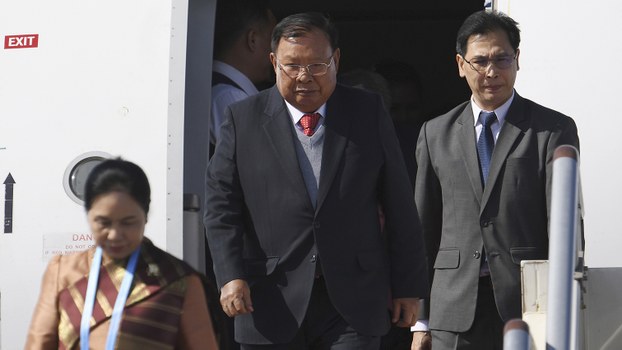




The president of Laos is fully behind China’s Belt and Road initiative, saying that the Lao-China railway will transform the country’s infrastructure and improve the lives of the people by jumpstarting economic development and connecting the land-locked Southeast Asian nation with many other countries.
President Bounnhang Vorachith made the remarks over the weekend during the Belt and Road forum in Beijing, the second global gathering of leaders since China launched President Xi Jinping’s signature infrastructure project in 2013.
The president underscored that Laos if completely on board with the Belt and Road Initiative--a trillion dollar development program linking China with scores of countries in Asia, Europe and Africa that Chinese state media has called the Middle Kingdom's ambitious bid to, in China's words, "enhance regional connectivity and embrace a brighter future together." The president also said Laos will cooperate fully with Beijing for all projects within Laos in order to benefit the country and people.
Laos expects the railway’s 420-kilometer (261-mile) route through the country, projected to be completed in 2021, to lower the cost of exports and consumer goods while boosting socioeconomic development in the impoverished nation of nearly 7 million people. It is part of a longer railway that will extend southward through the Malay peninsula to Singapore.
While the government believes the Lao portion will be a net success for its economy, many Laotians have experienced mostly hardship from the $6 billion project.
A villager from Luang Prabang province told RFA’s Lao Service in an interview that although he and his family were not well off before the railway project, they were doing just fine. Now with no land and no means of support, they are struggling.
“There has been more hardship than before because I had a small store to [support] my family. Now after resettlement we have no income and it’s been so difficult. We have to pay for food and every other necessity,” he said.
Many of the displaced residents have yet to receive compensation they were promised as a condition of relocation for the railroad. Compensatory payments have not yet reached everyone, and those who have yet to collect don’t know when they will get what they were promised.
A local official from Vientiane’s Phon Hong district, on the condition of anonymity, said that he didn’t understand why payments haven’t yet been made.
“Money has been given to the district already, so we don’t know why the villagers haven’t gotten it yet,” he said.
“Members of parliament have already delivered on their offer already but the district was told to wait without revealing the month and day that they are planning to pay [the villagers],” he added.
An official involved in the compensation effort said that the government is accelerating payments, and is trying to prioritize payments to those who are most in need. The official said that there have been five rounds of compensation payments made and that all payments are expected to be completed by the end of 2020.
“We will follow up closely on compensation for the Lao-China rail project, especially to compensation for affected villagers to be made faster, in order to avoid complaints and to prevent a deterioration in the image for the state and central governments,” he said.
Previous reports from RFA’s Lao Service have indicated that the lack of compensation has been a consistent problem.
For example, in the capital city, only 20 families out of several hundred have received compensation for their losses. In other areas touched by the project, similar rates of compensation have been observed.
Altogether 4,411 families in Laos have been affected by the rail project over 13 districts of four provinces and the capital, but only about 230 have received compensation.
Reported by RFA’s Lao Service. Translated by Sidney Khotpanya. Written in English by Eugene Whong.